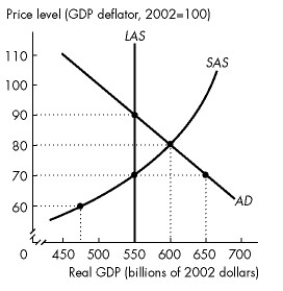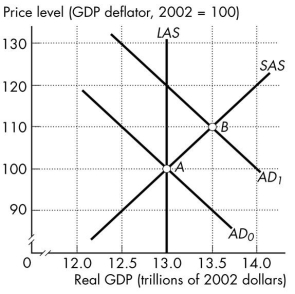A) (1) is true; (2) is false.
B) (2) is true; (1) is false.
C) (1) and (2) are false.
D) (1) and (2) are true.
E) (1) is true; (2) is true if the natural unemployment rate is too high.
G) None of the above
Correct Answer

verified
A
Correct Answer
verified
Multiple Choice
Canada's exports to the European Union boom. What is the effect on the quantity of real GDP demanded or aggregate demand in Canada?
A) The quantity of Canadian real GDP demanded increases.
B) The quantity of Canadian real GDP demanded decreases.
C) Canadian aggregate demand increases.
D) Canadian aggregate demand decreases.
E) There is no change to either the quantity of real GDP demanded or to aggregate demand.
G) A) and C)
Correct Answer

verified
Correct Answer
verified
Multiple Choice
Table 26.3.1
 41) Refer to Table 26.3.1. Consider the economy represented in the table. In short-run macroeconomic equilibrium, the price level is ________ and the level of real GDP is ________ billion.
-Refer to Table 26.3.1. Consider the economy represented in the table. The economy is in
41) Refer to Table 26.3.1. Consider the economy represented in the table. In short-run macroeconomic equilibrium, the price level is ________ and the level of real GDP is ________ billion.
-Refer to Table 26.3.1. Consider the economy represented in the table. The economy is in
A) a long-run equilibrium, and resource prices will not change.
B) an above full-employment equilibrium, and factor prices will increase.
C) an above full-employment equilibrium, and factor prices will decrease.
D) a below full-employment equilibrium, and factor prices will decrease.
E) a below full-employment equilibrium, and factor prices will increase.
G) A) and C)
Correct Answer

verified
Correct Answer
verified
Multiple Choice
If real GDP is greater than potential GDP, we would expect
A) the money wage rate to fall.
B) the money wage rate to rise.
C) potential GDP to increase.
D) potential GDP to decrease.
E) the expected future inflation rate to decrease.
G) B) and C)
Correct Answer

verified
Correct Answer
verified
Multiple Choice
Consider an economy starting from a position of full employment. Which one of the following changes does not occur as a result of a decrease in aggregate demand?
A) The price level decreases.
B) The level of real GDP decreases in the short run.
C) A recessionary gap arises.
D) Factor prices decrease in the long run, shifting the short-run aggregate supply curve rightward.
E) The long-run aggregate supply curve shifts leftward to create the new long-run equilibrium.
G) B) and C)
Correct Answer

verified
Correct Answer
verified
Multiple Choice
The Canadian price level rises. What is the effect on the quantity of real GDP demanded or aggregate demand in Canada?
A) The quantity of Canadian real GDP demanded increases.
B) The quantity of Canadian real GDP demanded decreases.
C) Canadian aggregate demand increases.
D) Canadian aggregate demand decreases.
E) There is no change to either the quantity of real GDP demanded or to aggregate demand.
G) D) and E)
Correct Answer

verified
Correct Answer
verified
Multiple Choice
Aggregate demand is the relationship between
A) real aggregate expenditure and real GDP.
B) real income and real GDP.
C) real prices and real GDP.
D) the price level and the quantity of real GDP demanded.
E) the price level and nominal GDP.
G) A) and B)
Correct Answer

verified
Correct Answer
verified
Multiple Choice
Which one of the following newspaper quotations describes a movement along an LAS curve?
A) "The decrease in consumer spending may lead to a recession."
B) "The increase in consumer spending is expected to lead to inflation, without any increase in real GDP."
C) "Recent higher wage settlements are expected to cause higher inflation this year."
D) "Growth has been unusually high the last few years due to more women entering the labour force."
E) "The recent tornadoes destroyed many factories in Calgary and Edmonton."
G) All of the above
Correct Answer

verified
Correct Answer
verified
Multiple Choice
When an economy is operating on its long-run aggregate supply curve,
A) the actual inflation rate is greater than the anticipated inflation rate.
B) the actual unemployment rate equals the natural unemployment rate.
C) unemployment will fall to an unusually low rate that is not likely to last into the future.
D) real GDP demanded exceeds real GDP supplied.
E) inflation must be positive.
G) B) and D)
Correct Answer

verified
Correct Answer
verified
Multiple Choice
Which of the following statements about the Keynesian view of the macroeconomy is incorrect?
A) Technological change is the most significant influence on both aggregate demand and aggregate supply.
B) To achieve and maintain full employment, active help from fiscal policy and monetary policy is required.
C) Expectations are based on "animal spirits."
D) The money wage rate is extremely sticky in the downward direction so there is no automatic mechanism for eliminating a recessionary gap.
E) Expectations are the most significant influence on aggregate demand.
G) A) and B)
Correct Answer

verified
Correct Answer
verified
Multiple Choice
Figure 26.3.2
 -Refer to Figure 26.3.2. In Mythlo there is a difference between the ________ equilibrium real GDP and potential GDP of ________ billion.
-Refer to Figure 26.3.2. In Mythlo there is a difference between the ________ equilibrium real GDP and potential GDP of ________ billion.
A) above full-employment; $50
B) above full-employment; $25
C) below full-employment; $50
D) below full-employment; $25
E) full employment; 0
G) A) and B)
Correct Answer

verified
Correct Answer
verified
Multiple Choice
Figure 26.3.5
 -Refer to Figure 26.3.5. Potential GDP is
-Refer to Figure 26.3.5. Potential GDP is
A) $13 trillion.
B) $13.5 trillion.
C) more than $13 trillion and less than $13.5 trillion.
D) less than $13 trillion.
E) 100
G) A) and D)
Correct Answer

verified
A
Correct Answer
verified
Multiple Choice
Consider an economy starting from a position of full employment. Which one of the following occurs as a result of an advance in technology?
A) The price level falls.
B) Real GDP decreases in the short run.
C) An inflationary gap arises.
D) Factor prices rise in the long run, shifting the short-run aggregate supply curve leftward.
E) The long-run aggregate supply curve shifts leftward to create the new long-run equilibrium.
G) A) and B)
Correct Answer

verified
Correct Answer
verified
Multiple Choice
Disposable income is aggregate income
A) minus taxes and benefits.
B) minus taxes plus transfer payments.
C) minus fixed expenses such as rent and utilities.
D) plus transfer payments.
E) minus taxes.
G) A) and C)
Correct Answer

verified
B
Correct Answer
verified
Multiple Choice
Figure 26.3.2
 -Refer to Figure 26.3.2. If the economy of Mythlo automatically adjusts to long-run equilibrium, then
-Refer to Figure 26.3.2. If the economy of Mythlo automatically adjusts to long-run equilibrium, then
A) the price level rises to 90.
B) real GDP is $600 billion.
C) the actual unemployment rate exceeds the natural unemployment rate.
D) potential GDP decreases.
E) the SAS curve shifts rightward.
G) None of the above
Correct Answer

verified
Correct Answer
verified
Multiple Choice
Which one of the following variables is not held constant along a given aggregate demand curve?
A) fiscal policy
B) monetary policy
C) the exchange rate
D) expectations about inflation
E) the price level
G) B) and C)
Correct Answer

verified
Correct Answer
verified
Multiple Choice
Table 26.3.1
 41) Refer to Table 26.3.1. Consider the economy represented in the table. In short-run macroeconomic equilibrium, the price level is ________ and the level of real GDP is ________ billion.
-Refer to Table 26.3.1. Consider the economy represented in the table. In short-run macroeconomic equilibrium, the price level is ________ and the level of real GDP is ________ billion.
41) Refer to Table 26.3.1. Consider the economy represented in the table. In short-run macroeconomic equilibrium, the price level is ________ and the level of real GDP is ________ billion.
-Refer to Table 26.3.1. Consider the economy represented in the table. In short-run macroeconomic equilibrium, the price level is ________ and the level of real GDP is ________ billion.
A) 120; $600
B) 120; $500
C) 125; $550
D) 130; $600
E) 130; $500
G) A) and C)
Correct Answer

verified
Correct Answer
verified
Multiple Choice
Full-employment equilibrium occurs when
A) aggregate demand equals short-run aggregate supply.
B) all who are willing and able to work, are working.
C) real GDP equals potential GDP.
D) real GDP equals potential GDP and the wage level is set so that the GDP deflator equals 100.
E) all who are willing and able to work are working, and the wage level is set so that the GDP deflator equals 100.
G) None of the above
Correct Answer

verified
Correct Answer
verified
Multiple Choice
Autoworkers agree to a cut in the nominal wage rate. This event ________ short-run aggregate supply and ________ long-run aggregate supply.
A) does not change; does not change
B) decreases; does not change;
C) increases; does not change;
D) increases; increases
E) decreases; does not change
G) C) and D)
Correct Answer

verified
Correct Answer
verified
Multiple Choice
The Canadian price level rises. This event
A) increases short-run aggregate supply.
B) increases the quantity of real GDP supplied.
C) decreases the quantity of real GDP supplied.
D) increases long-run aggregate supply.
E) decreases short-run aggregate supply.
G) C) and D)
Correct Answer

verified
Correct Answer
verified
Showing 1 - 20 of 136
Related Exams